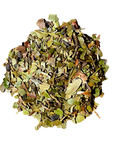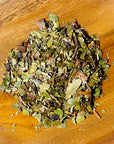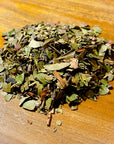


Uva Ursi
Botanical name: Arctostaphylos uva ursi
^Organic
Uva ursi, scientifically known as Arctostaphylos uva-ursi, is a low-growing evergreen shrub that belongs to the Ericaceae family. This plant is native to the northern regions of North America, Europe, and Asia, thriving in rocky, acidic soils and often found in heathlands and forests. Uva ursi is characterized by its leathery, dark green leaves and small, bell-shaped pink or white flowers that bloom in the spring.
In herbal medicine, uva ursi has been traditionally valued for its potential benefits relating to urinary health. The leaves are commonly used to make teas, tinctures, or extracts, offering a slightly bitter and astringent flavor. Historically, uva ursi has been utilized for its ability to support kidney and bladder function, as well as its use in various herbal remedies.*
*These statements have not been evaluated by the Food and Drug Administration. This product is not intended to diagnose, treat, cure, or prevent any disease. For educational purposes only.



